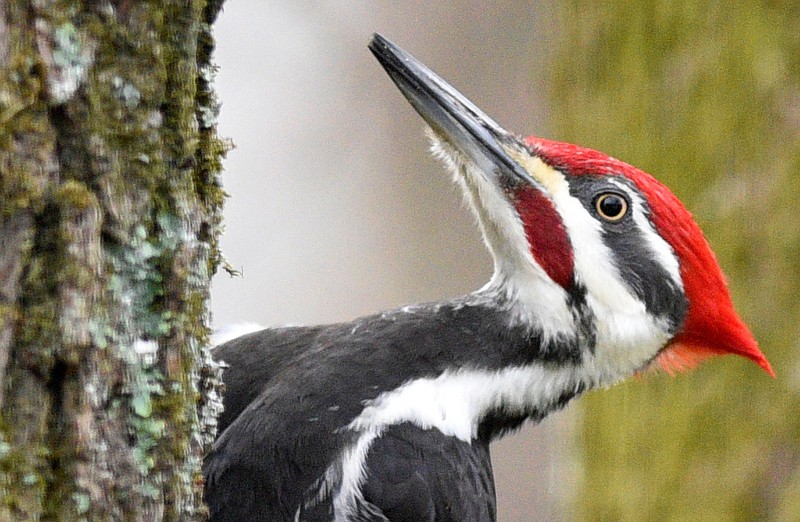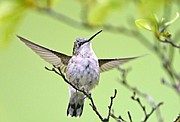For several weeks last spring, Laura Marsh banned her husband, Danny, from cooking on the grill. Not for the quality of his cooking, but for the Carolina wren nesting inside.
"I wouldn't let my husband use the grill until the babies fledged," said Marsh, who cites the species as one of her favorites.
These small but chunky birds have "a rolling 'tea-kettle, tea-kettle' [call] that is so piercing it usually drowns out other bird songs in the forest," she said.
Carolina wrens are common to the Chattanooga area, she said, and "like to nest in interesting places."
On Saturday, April 25, Marsh, founder of Nova Conservation, will lead an online class on backyard birdwatching for The Chattery.
Marsh said she started Nova Conservation to connect people, specifically non-biologists, to the work of wildlife conservationists.
"Coronavirus has stalled out some of our forward momentum, which is why I'm excited to be hosting an online class connecting people with nature," she said.
Participants in the class will learn the basics of birding from home, including how to identify the birds you see in your backyard, tips for using bird feeders and the use of binoculars and field guides.
"If you have a bird that frequents your feeder, I'll be able to see the bird from your screen and help identify it," Marsh said.
Photo Gallery
Bird watching in the Chattanooga area
Check out these bird photos from Times Free Press photographers that offer a peek into the lives of our feathery neighbors in the Chattanooga region.
Class info
To participate in Birdwatching From Your Couch, an online class taught by Laura Marsh of Nova Conservation, register at TheChattery.org. Cost is $15. It runs 9-10 a.m. Saturday, April 25.
Millions of Americans cite birding as a pastime, and social isolation stemming from the coronavirus pandemic has put more Americans at home where they can watch the backyard dramas of mating, nesting and fledgling play out this spring.
Kevin Calhoon, curator of forests at the Tennessee Aquarium, organizes the local contribution to the Great Backyard Bird Count, part of a network of counts conducted by citizen scientists who report their findings to the Cornell Lab of Ornithology. Volunteers from around the world are asked to count the birds they see for at least 15 minutes on one or more days of the count, held each February, then enter their checklists at birdcount.org.
Still to come is World Migratory Bird Day, held the second Saturday in May in the U.S. and Canada. There are several such counts throughout the year, each adhering to a regular schedule so that trends in the avian population can be observed.
"You stay with the same schedule each year so the data will be somewhat consistent," Calhoon said.
Among the common backyard birds observable all year long are American robins, northern cardinals and northern mockingbirds, Tennessee's state bird.
"Some common migrants that you might see or hear in your backyard, especially if you have scrubby, forested 'edge' habitat, include gray catbirds, white-eyed vireos, wood thrushes and indigo buntings. Male indigo buntings are solid deep blue, just beautiful to see in the sunlight," Marsh said.
For many homeowners, hummingbirds are a star, if rare, attraction. At this time of year, those spotted locally are almost exclusively ruby-throated hummingbirds, according to Marsh and Calhoon. If you're missing them in your yard, there are ways to make the landscape more welcoming.
"Native plants are a must," Marsh said. "Native honeysuckle, columbine, jewelweed and crossvine are a few examples of plants that attract hummingbirds. Trees and shrubs that are indigenous to this area are also ideal so they have places to perch and nest. Get rid of invasive plants, and minimize pesticide and herbicide use."
They also need a water source, such as a bird bath, "but anything with a dripping sound will attract them also," Calhoon said.
He suggests positioning hummingbird feeders near hanging baskets of flowers to provide cover.
While hummers are attracted to red and orange flowers, it's not necessary to dye the nectar for their feeders with red food coloring.
"Almost all [hummingbird feeders] have red on them," he said.
He suggests looking for a simple design with a glass reservoir for ease in cleaning.
"You do need to wash them occasionally," he said. "Plastic ones are harder to get clean."
You can buy commercial hummingbird nectar, but Calhoon and Marsh both recommend a simple solution of one cup sugar to four cups water. Boil the water, let the sugar crystals dissolve for a couple of minutes and let the solution cool.
Then fill the feeders halfway, Marsh said, and change the sugar water every few days so that it doesn't go bad or ferment.
"Clean with a solution of one part white vinegar to four parts water," she said. "Do not use artificial red color, sweetener or even honey."
Many homeowners remove their hummingbird feeders when it's time for the birds to migrate south, usually by October, but Calhoon said it can pay to leave them up.
"Occasionally we'll get a rare winter straggler, a species called a rufous hummingbird. They usually migrate west to east."
Attracting hummingbirds, or any birds, comes down to three factors, Calhoon said: "Give them lots of cover, lots of food and lots of water."
Contact Lisa Denton at ldenton@timesfreepress.com.

